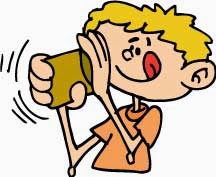Draw a circle, triangle, rectangle and square on the board (or whichever shapes you happen to be teaching).
Use the Shape Cube pattern below to create a cube (you can print the pattern onto 11 x 17-inch paper so you have a large cube that the entire class can easily see). Feel free to add more complex shapes as your students are ready for them.
Ask students to describe the figures on the board in terms of straight and curved lines, whether they are open or closed, the number of sides and if there are “square” vertices or corners.
If the students are not familiar with these terms, point out what you mean on one of the figures on your Cube and ask them how they would describe that characteristic.
 |
| Excel Math Shape Cube Click here to download the PDF file. |

Now group students into pairs. One student per pair rolls the Shapes Cube and describes one attribute of a shape on the sides or top of the cube. The other student tries to guess which shape has been chosen.
If the student guesses incorrectly, he can ask questions that can be answered with a yes or a no to find the correct shape. The questions must relate to characteristics of the shape. For example the student cannot ask, “Is it a rectangle?” but rather, “Does it have 3 vertices?” If you are also teaching your students colors, let them ask a question about the color of the shape as well as the other attributes. When the student thinks he knows the shape, he should turn the cube so the shape is on top. If he is wrong, the other player turns the shape back to its previous position and play continues. When the shape is guessed correctly, the guessing player now rolls the cube and chooses a shape to describe.
 Older students can also describe the shapes as polygons, parallelograms, etc. You can add shapes to the cube (pentagon, hexagon, cube, cone, etc.) by gluing various shapes onto the cube pattern before copying it for each student. Or let each student color various shapes and glue them onto their cube to make it unique.
Older students can also describe the shapes as polygons, parallelograms, etc. You can add shapes to the cube (pentagon, hexagon, cube, cone, etc.) by gluing various shapes onto the cube pattern before copying it for each student. Or let each student color various shapes and glue them onto their cube to make it unique.Next have both students roll their cubes at your signal. Give them each a pencil and paper. The students look at the shape facing up. They write down as many similar attributes (or differences between the shapes) as they can before you call "time." You can allow 30 seconds to one minute, depending on your students and the level of difficulty of the shapes. Let a few students read their attributes aloud while the class guesses which shapes are being described.
Draw some shapes on the board and let your students take turns putting a “C” on circles, a “T” on triangles and an “R” on rectangles, etc. Then name a shape and let your students draw it. They can use various art forms to create shapes as you name them. (Yarn, foil or modeling clay with a stylus, sand with a stick, fingerpaint, etc.
Ask students to “explain their thinking” as they work. Asking students to describe their work will help you to determine the students’ depth of understanding and will give you a chance to clear up any misconceptions.
Adapt your lesson to the needs of your class. If your students are having difficulty with a concept, take time to practice that concept or reteach it the next day before moving on to the next lesson.
As you anticipate opportunities to reteach, you will be better equipped to address the specific learning needs of your students. Encourage your students to ask for help so you can clear up any misconceptions as soon as they occur.
Because Excel Math Lessons have a unique spiraling system that has students review previously taught concepts during Guided Practice, you do not need to look for total mastery for the whole class before moving on to other concepts. Learn more . . .
Read more . . .


No comments:
Post a Comment
Type your comment here